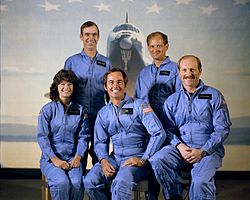STS-7
| Mission emblem | |||
|---|---|---|---|

|
|||
| Mission dates | |||
| Mission: | STS-7 | ||
| COSPAR-ID : | 1983-059A | ||
| Crew: | 5 | ||
| Begin: | June 18, 1983, 11:33:00 UTC | ||
| Starting place: | Kennedy Space Center , LC-39A | ||
| Landing: | June 24, 1983, 13:56:59 UTC | ||
| Landing place: | Edwards Air Force Base , Runway 15 | ||
| Flight duration: | 6d 2h 23min 59s | ||
| Earth orbits: | 98 | ||
| Track height: | 307 km | ||
| Orbit inclination : | 28.3 ° | ||
| Covered track: | 4.0 million km | ||
| Payload: | Anik C-2, Palapa-B1 | ||
| Team photo | |||
 v. l. No. Sally Ride, John Fabian, Robert Crippen, Norman Thagard, Frederick Hauck |
|||
| ◄ Before / After ► | |||
|
|||
STS-7 ( English S pace T ransportation S ystem ) is the mission name for a space flight of the US space shuttle Challenger (OV-99) of NASA . The launch took place on June 18, 1983. It was the seventh space shuttle mission and the second flight of the space shuttle Challenger.
team
- Robert Crippen (2nd space flight), commander
- Frederick Hauck (1st space flight), pilot
- John Fabian (1st spaceflight), mission specialist
- Sally Ride (1st spaceflight), mission specialist
- Norman Thagard (1st spaceflight), mission specialist
Mission overview
The shuttle flight STS-7 took off punctually on June 18, 1983 at 11:33 UTC from the Kennedy Space Center (KSC) in Florida . This marked the beginning of an American woman's first flight into space. It was also the first time that five people flew into space in a spaceship. The mission in command was Robert Crippen, who had already been a pilot on the first shuttle flight. This was the first shuttle flight in which a former shuttle pilot was promoted to command, which from then on increasingly became the norm. (The commanders had always been former Apollo astronauts on the first six shuttle flights.) The other four astronauts were newcomers, so they had never done space flights. With them, members of the eighth astronaut group came for the first time in January 1978 on a space flight. Frederick Hauck served as the pilot, and mission specialists were John Fabian, Sally Ride and Norman Thagard.
The payload consisted of the communication satellites Anik C-2 for the Canadian Telesat and Palapa-B1 for Indonesia . The two satellites were successfully deployed during the first two days of flight. The Challenger also carried the Shuttle Pallet Satellite (SPAS-l), an experimental platform developed by the German company Messerschmitt-Bölkow-Blohm . The six meter long and one meter wide platform was transported into orbit in the payload bay and could then be released into free space by the robot arm . The platform contained ten experiments. Among other things, the behavior of metal alloys in weightlessness was investigated and experiments with heat pipes were carried out.
Seven further experiments were carried out in so-called getaway special containers that were installed in the payload bay. These are special containers that can take simple, independently running experiments into the room. For example, students get a relatively cheap opportunity to conduct research in weightlessness themselves. One of the containers contained a colony of ants whose social behavior was examined in weightlessness .
The STS-7 mission should have been the first shuttle flight that should have landed on the Shuttle Landing Facility at KSC in order to be able to save the transfer of the shuttle with the Shuttle Carrier Aircraft back to Florida. Bad weather made this impossible, however, and so the Challenger landed on June 24 shortly before 2 p.m. UTC after 97 orbits the earth at Edwards Air Force Base in California . Five days later, the space shuttle began its journey back to KSC, where it was being prepared for the next flight, STS-8 .
Incidents

In orbit, the shuttle was hit by a piece of space debris, damaging a window pane.
See also
Web links
swell
- NASA: Mission Overview (English)
- NASA: video summary with comments of the crew (English)



